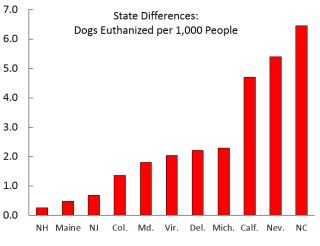Animal Behavior
The Puzzling Geography of Animal Shelter Dog Euthanasia
The cruel geography of deaths in animal shelters.
Posted May 11, 2018

In 1973, there were 65 million pet dogs and cats in the United States, and 20% of this number were put to death in animal shelters. Today, there are 160 million pet dogs and cats but less than 2% of that number is euthanized in shelters. In a recent article in the journal Animals, Andrew Rowan and Tamara Kartal examine the reasons for this 90% drop and raise an intriguing and important question: Why does geography determine whether a shelter dog will be euthanized?
The Big Drop in Animal Shelter Dog and Cat Deaths
As shown in the graph above, the rate of unwanted pet euthanasia per 1,000 people has dropped precipitously. Rowan and Kartal attribute this impressive decline in shelter animal deaths to several factors. In the 1970s, groups such as the Humane Society of the United States, the American Humane Association, and the American Veterinary Medical Association made the pet overpopulation crisis a high-profile national issue. As the spay and neuter movement became a moral crusade, cities and states began establishing low-cost sterilization programs and enacting mandatory dog licensing regulations. Presently, 32 states require that dogs adopted from a shelter be sterilized, and the percentage of American dogs that are spayed or neutered has increased from 10% to nearly 85%.
A second factor for the fall in shelter deaths dates to the early 2000s when the number of dogs and cats successfully adopted from shelters began to rise. This trend was, in part, due to the efforts of animal protection organizations to encourage people seeking a pet to adopt a dog or cat from an animal shelter rather than purchasing a companion animal from a pet store. PETA, for example, equated buying a purebred puppy with killing a shelter dog. (About the same time, American Kennel Club pedigree puppy registrations began to tank.) Finally, Rowan and Kartal note that there has been a major cultural shift in how Americans think about animals. A large majority of owners now think of dogs and cats as family members. This trend toward the humanization of pets has resulted in more adoptions and fewer deaths of healthy animals in shelters.
Is Geography Destiny?
While the drop in deaths is impressive, the odds that a dog or cat will survive a stint in an animal shelter depend on where it lives. Rowan and Kartal obtained rates of canine shelter deaths in eleven states. This graph shows the number of dogs killed per 1,000 people in each state. In my state, North Carolina, a healthy dog in an animal shelter is nearly 25 times more likely to be euthanized than a dog in New Hampshire. It would be easy to assume that this is simply due to regional differences in attitudes toward animals. That theory, however, does not explain why a North Carolina dog is three times more likely to die in a shelter than a dog in the neighboring state of Virginia. Nor does it explain why California, one of the most progressive states, has a dog euthanasia rate three and a half times greater than Colorado.

Other factors also seem to be involved—for example, attitudes toward government regulations. Perhaps people in the South don’t like restrictions on the sex lives of their pets any more than they like zoning or gun laws. To test this hypothesis, I did a statistical analysis of differences between states in shelter dog deaths, gun ownership rates, and average income. The relationship between dog deaths and gun ownership was not as high as with income and was in the opposite direction: States with lower average incomes and higher rates of gun ownership had more shelter dog deaths.
The Scandinavian Paradox
The same kinds of geographic differences in healthy pet deaths also exist between countries. In the US, the overall rate of shelter euthanasia is 5.6 per 1,000 people. But in the UK, the rate is 0.2. And in Sweden, it is close to zero despite the fact that only 20% of Swedish dogs are neutered. This is less than a fourth of the pet sterilization rate in the United States. Neither does Norway have an unwanted pet problem even though routine castration of dogs is not permitted under their Animal Welfare Act. (Neutering is allowed for medical reasons.)
Puzzled by this “Scandinavian Paradox,” I turned to Dr. Peter Sandøe, a bioethicist at the University of Copenhagen. He explained why countries with such low spay and neuter rates have hardly any problems with unwanted dogs. First, he said, there are simply fewer dogs in these nations. For example, 20% of Danish households include a dog, compared to 36% of US homes. Second, Scandinavian countries have strict laws dictating that dogs be under their owners’ control at all times, and dogs are not allowed to roam freely. Finally, he attributes the low euthanasia rates to the fact that Scandinavians have a generally law-abiding culture.
Unwanted Pet Euthanasia and Moral Progress
On the morning of July 5, 1877, a large crowd of New Yorkers gathered on the banks of the East River to watch the authorities drown stray dogs. Forty-eight animals at a time were crammed into a heavy iron cage dubbed “the canine bathtub.” Then the cage was slowly lowered into the river. After ten minutes, the cage was raised, the corpses removed, and the cage reloaded. According to The New York Times, 762 dogs were killed that day.
Animal protectionists can take heart in knowing we have come a long way since the days when unwanted dogs and cats were drowned en masse. The decline in euthanasia of animals in the United States from nearly 25 million a year to fewer than 2 million represents considerable moral progress. Indeed, I believe it is the single biggest success of the modern animal protection movement. Even today in the United States, however, dogs and cats in shelters are put to death at a rate of 4 animals every minute. There is plenty of room for improvement.
References
Rowan, A., & Kartal, T. (2018). Dog population and dog sheltering trends in the United States of America. Animals: 8(5).


